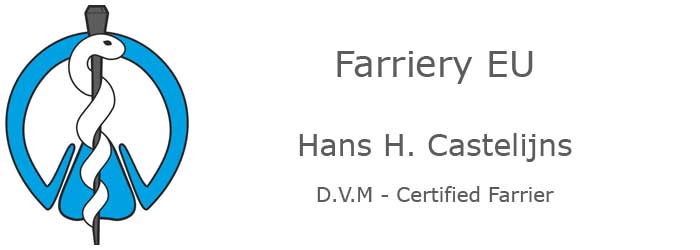 |
A case of keratoma and it's treatmentKeratomas are benign tumors, which originate at the coronary corion (the cylindrical one's) or at the laminar or solar corion (spherical one's). They are rare but perhaps not as rare as one may think, in fact German even has a farriery - podiatry term for the condition (Hornsaule).
Keratomas cause lameness in the long run because they occupy space between the inside of the hoof capsule and the distal phalanx (coffin bone), gradually eroding and compressing this bone as they grow. Also the cylindrical keratoma's are often accompanied by recurring abscesses. The clinical case presented here is a 23 year old gelding with a 2 year history of recurrent lameness on the fore right which presented the typical deformation of the white line on the solar surface of its affected foot. The half moon shaped erosion of the distal margin of the lateral aspect of the pedal bone, visible on the x rays, confirmed the diagnosis. The horse was operated on standing under sedation, with local anesthesia and Esmarck bandage (tourniquet) after having his foot soaked for 24 hours in an antiseptic bandage and shoeing the controlateral foot with frog support as a preventive measure against weight bearing laminitis. The distal part of the keratoma was isolated from the surrounding sole with sterilized hoof knives, two cuts along the horn tubules dorsal and palmar to the under lying keratoma were made with the help of a sterilized cast cutter blade to the full depth of the wall. With a pair of pull offs the isolated piece of hoof wall with the under lying cylinder where lifted upwards and the periople was carefully cut with a surgical blade. The hoof was shod with a ring shoe with clips in front and behind the defect, hospital plate, dental impression material (condensation silicone) as palmar support and a stainless steel plate was screwed on the hoof wall to stabilize its upper portions and to help keep in place a compressive bandage. After two further shoeings (116 days postop), the horse began gentle work on the lounge and 151 days post operation the horse was being ridden again, lameness free. The erosion of the distal phalanx is of course a permanent damage, and as in this case its location was in the quarter area where the lateral palmar process ("wing") joins the main body of the pedal bone, this particular horse will always need careful preventive shoeing to limit the risk of a "wing" fracture. Since the farrier knows the feet of his clients' horses best, it is good practice to be on the look out for signs of Keratomas before they cause lameness and serious and permanent bone loss. Another good argument for the necessary and wholesome partner ship between farrier and Vet. Bibliography on request. |
|
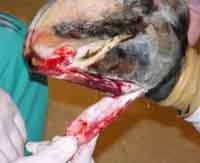 |
|
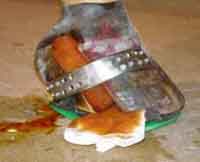 |
|
 |
|
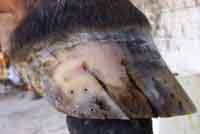 |
|
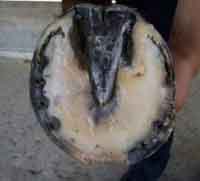 |
Hans Castelijns
D.V.M - Certified Farrier
